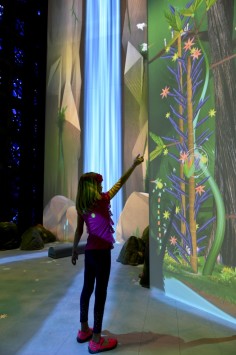Design I/O
Theo Watson, Emily Gobeille and Nick Hardeman
Connected Worlds

source: pixelkinorg
Connected Worlds is an immersive, interactive ecosystem that was designed for the New York Hall of Science. It’s an installation of six smaller ecosystems, actually—all of which are connected, much like real ecosystems are. The difference here is that the environments only exist on massive screens connected by a 3,000-ft² interactive floor.
Kids can plant seeds with their hands and use logs to create water movement. The goal is for kids to work together to distribute water to each area in the system by diverting streams with logs and using living plants to absorb or manage water flow. The system includes the cycle of evaporation and weather. Healthy ecosystems will begin to produce animal life, as well!
Connected Worlds was designed by Design I/O in collaboration with the New York Hall of Science. Game designer Zach Gage consulted for the project.
“My biggest pushes were for ensuring that the takeaways for children were experiential (to be unpacked later with educators/family members/friends) rather than a set of point-by-point facts or statistics,” Gage wrote. “I strongly believe that part of the power of games is that they can convey experiences, not just lessons, and that experiences can be key in teaching certain topics that are too complex to ever truly understand—in this case, systems thinking.”
What do you think? Do you want something like this in your local science museum?
.
.
.
.
.
.
.
source: design-io
AN INTERACTIVE CONNECTED ECOSYSTEM
Connected Worlds is a large scale immersive, interactive ecosystem developed for the New York Hall of Science. The installation is composed of six interactive ecosystems spread out across the walls of the Great Hall, connected together by a 3000 sqft interactive floor and a 45ft high waterfall. Children can use physical logs to divert water flowing across the floor from the waterfall into the different environments, where they can then use their hands to plant seeds. As the different environments bloom, creatures appear based on the health of the environment and the type of plants growing in it. If multiple environments are healthy creatures will migrate between them causing interesting chain reactions of behaviors.
Connected Worlds is designed to encourage a systems thinking approach to sustainability where local actions in one environment may have global consequences. Children work with a fixed amount of water in the system and have to work together to manage and distribute the water across the different environments. Clouds return water from the environments to the waterfall which releases water to the floor when it rains.
Connected Worlds was conceived, designed and developed by Design I/O in collaboration with the New York Hall of Science. Connected Worlds is made possible with generous support from The JPB Foundation, the National Science Foundation, Google Inc., and The Nasdaq Educational Foundation, Inc. The Design I/O team consisted of Emily Gobeille, Theo Watson and Nicholas Hardeman with additional design and animation by Josh Goodrich and game consultation by Zach Gage. Sound Design by MOST Original Soundtracks. Photos by David Handschuh.
Connected Worlds was developed with openFrameworks an open source creative coding toolkit.
.
.
.
.
.
.
.
source: design-io
Design I/O is a creative studio specializing in the design and development of cutting edge, immersive, interactive installations. Design I/O develops installations for events, galleries, museums, exhibitions and public space and specializes in creating engaging, meaningful interaction with the public. With more than 15 years experience in interactive media, Design I/O and its partners have and continue to push the boundaries of what is possible in the intersection between design and technology.
THEODORE WATSON
Partner / Creative Director
Theo Watson is an artist, designer and experimenter whose work is born out of the curiosity and excitement of designing experiences that come alive and invite people to play. Theodore’s work ranges from creating new tools for artistic expression, experimental musical systems, to immersive, interactive environments with full-body interaction. His recent work includes The Eyewriter, an eye controlled drawing tool, Graffiti Research Lab’s Laser Tag, laser graffiti system and Funky Forest, an immersive interactive ecosystem for young children. Theodore works together with Zachary Lieberman and Arturo Castro on openFrameworks, which is an open source library for writing creative code in C++.
Emily Gobeille is an artist and award-winning designer who specializes in merging technology and design to create rich immersive design experiences. Working in concept development, visual design, interaction design and creative direction, her experience over the past ten years spans many disciplines, including web, print, motion graphics, wireless platforms and installations. Emily’s unbound energy and affinity for telling stories lends to her playful approach to projects. With an emphasis on meaningful interaction and systems built to support open play and discovery, her work creates a sense of wonder and delight.
NICK HARDEMAN
Minister for Interactive Art
Nick Hardeman is a new media artist, designer, and experimenter. Nick enjoys drawing, painting and combining traditional mediums with emerging technologies. He utilizes technology to create immersive environments that bring wonderment and provoke discovery through exploration. Nick’s work includes fine art, interactive installations, mobile and online applications that investigate new modes of creative expression.

